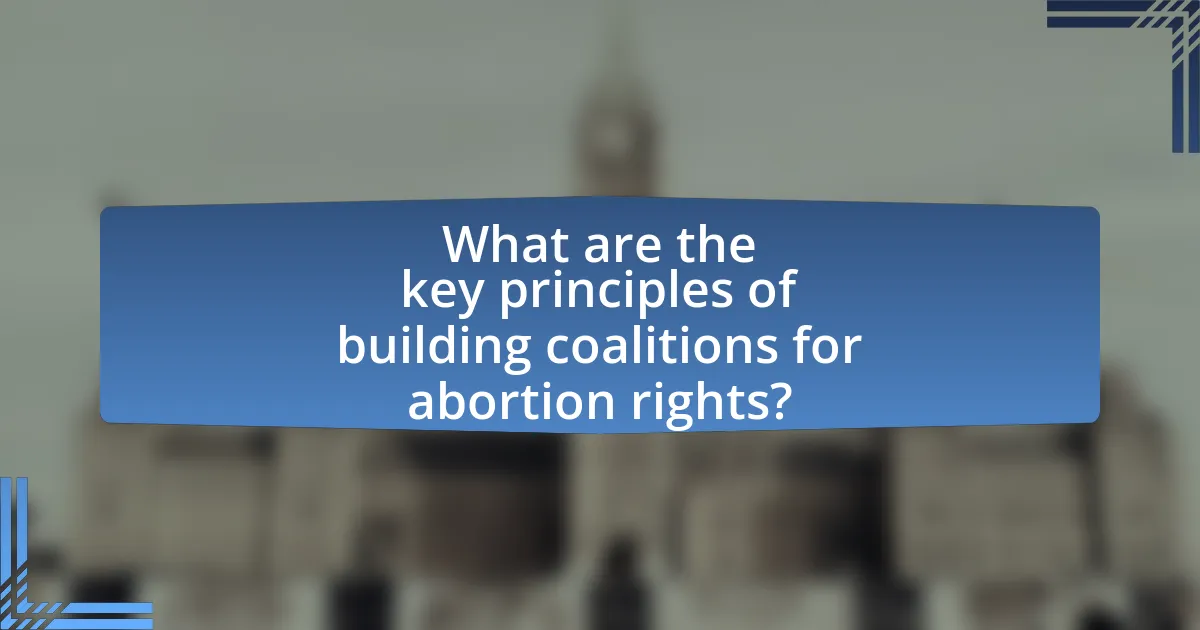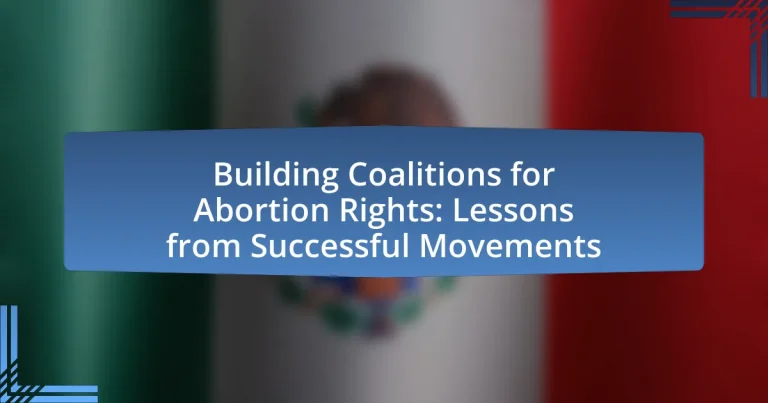The article focuses on building coalitions for abortion rights, emphasizing key principles such as inclusivity, shared goals, effective communication, and strategic alliances. It outlines how successful movements define their objectives, achieve specific goals, and align with broader social justice initiatives. The article also discusses strategies for mobilizing support, engaging stakeholders, and the importance of grassroots organizing and intersectionality. Additionally, it highlights common challenges faced by coalitions, lessons learned from past movements, and practical tips for enhancing coalition-building efforts in the context of abortion rights advocacy.

What are the key principles of building coalitions for abortion rights?
The key principles of building coalitions for abortion rights include inclusivity, shared goals, effective communication, and strategic alliances. Inclusivity ensures that diverse voices, particularly those from marginalized communities, are represented, fostering a broader base of support. Shared goals align the coalition’s members around common objectives, such as protecting reproductive rights and access to safe abortion services. Effective communication facilitates transparency and collaboration among coalition members, enhancing trust and coordination. Strategic alliances with other social justice movements amplify the coalition’s impact, leveraging resources and networks to advocate for abortion rights more effectively. These principles are supported by successful movements that have demonstrated the importance of unity and collaboration in achieving legislative and societal change.
How do successful movements define their goals and objectives?
Successful movements define their goals and objectives through a clear articulation of their mission, which is often rooted in shared values and collective experiences. For instance, the civil rights movement established specific goals such as desegregation and voting rights, which were communicated effectively to mobilize support and unify participants. This clarity allows movements to create actionable strategies and measurable outcomes, ensuring that all members understand their purpose and direction. Historical examples, like the women’s suffrage movement, demonstrate that well-defined objectives, such as securing the right to vote, can galvanize public support and lead to significant legislative changes.
What specific goals have been achieved by past coalitions?
Past coalitions for abortion rights have achieved specific goals such as the legalization of abortion in various jurisdictions, the establishment of comprehensive reproductive health services, and the protection of abortion rights through legislative measures. For instance, the coalition efforts in the United States led to the landmark Supreme Court decision in Roe v. Wade in 1973, which legalized abortion nationwide. Additionally, coalitions have successfully influenced policy changes that expanded access to reproductive health services, including funding for clinics and educational programs. These achievements demonstrate the effectiveness of organized advocacy in shaping abortion rights and reproductive health policies.
How do these goals align with broader social justice movements?
The goals of building coalitions for abortion rights align with broader social justice movements by advocating for reproductive rights as a fundamental aspect of gender equality and human rights. These coalitions emphasize the intersectionality of issues such as race, class, and gender, recognizing that access to abortion is crucial for marginalized communities. For instance, the Women’s March and Black Lives Matter have both highlighted reproductive justice as essential to their missions, illustrating how the fight for abortion rights is interconnected with the struggle against systemic oppression and inequality. This alignment is further supported by research from the Center for Reproductive Rights, which shows that restricting abortion access disproportionately affects low-income women and women of color, reinforcing the need for a unified approach to social justice that includes reproductive rights.
What strategies do effective coalitions employ to mobilize support?
Effective coalitions mobilize support through strategic communication, inclusive engagement, and targeted advocacy efforts. Strategic communication involves crafting clear, compelling messages that resonate with diverse audiences, ensuring that the coalition’s goals are understood and supported. Inclusive engagement means actively involving various stakeholders, including marginalized communities, to foster a sense of ownership and commitment to the cause. Targeted advocacy efforts focus on specific policy changes or public awareness campaigns that align with the coalition’s objectives, utilizing data and personal stories to highlight the importance of the issue. For instance, successful coalitions often leverage social media platforms to amplify their messages and mobilize grassroots support, as seen in movements like the Women’s March, which effectively united millions around reproductive rights.
How do coalitions identify and engage stakeholders?
Coalitions identify and engage stakeholders through systematic mapping and outreach strategies. They begin by analyzing the landscape of potential stakeholders, including individuals, organizations, and communities that have an interest in abortion rights. This involves identifying key players, such as advocacy groups, healthcare providers, and affected populations, who can influence or be impacted by coalition activities.
Once stakeholders are identified, coalitions engage them through targeted communication, collaborative meetings, and inclusive decision-making processes. For instance, successful coalitions often utilize surveys and focus groups to gather input and foster relationships, ensuring that diverse voices are represented. This approach not only builds trust but also enhances the coalition’s credibility and effectiveness in advocating for abortion rights.
What role does grassroots organizing play in coalition-building?
Grassroots organizing is essential in coalition-building as it mobilizes community members to advocate for shared goals, fostering a sense of ownership and collective action. This approach enables diverse groups to unite around common issues, such as abortion rights, by leveraging local knowledge and networks to amplify their voices. Historical examples, such as the Women’s March in 2017, demonstrate how grassroots efforts can effectively bring together various organizations and individuals, creating a powerful coalition that influences policy and public opinion. By engaging directly with communities, grassroots organizing not only builds trust but also ensures that the coalition reflects the needs and perspectives of those it aims to represent.
Why is intersectionality important in abortion rights coalitions?
Intersectionality is important in abortion rights coalitions because it recognizes and addresses the diverse experiences and challenges faced by individuals based on their intersecting identities, such as race, gender, socioeconomic status, and sexual orientation. This approach ensures that the coalition’s strategies and policies are inclusive and equitable, allowing for a more comprehensive understanding of how various factors impact access to abortion services. For instance, research by the Guttmacher Institute highlights that marginalized groups, including women of color and low-income individuals, face greater barriers to accessing reproductive healthcare, including abortion. By incorporating intersectionality, coalitions can advocate for policies that specifically address these disparities, ultimately leading to more effective and just outcomes for all individuals seeking abortion rights.
How do diverse perspectives enhance coalition effectiveness?
Diverse perspectives enhance coalition effectiveness by fostering innovative solutions and broadening the understanding of issues. When individuals from various backgrounds collaborate, they bring unique insights and experiences that can identify challenges and opportunities that a homogenous group might overlook. Research indicates that diverse teams are 35% more likely to outperform their less diverse counterparts, as they leverage a wider range of ideas and approaches to problem-solving. This diversity not only enriches discussions but also strengthens the coalition’s ability to advocate for abortion rights by appealing to a broader audience and addressing the needs of different communities.
What challenges arise from differing priorities within coalitions?
Differing priorities within coalitions create significant challenges, including conflict over resource allocation, misalignment of goals, and decreased cohesion among members. For instance, when coalition partners prioritize different aspects of abortion rights—such as access, education, or legislative reform—disagreements can arise, leading to inefficiencies and a lack of unified action. Research indicates that coalitions with clear, shared objectives are more effective; thus, when priorities diverge, the coalition’s overall impact may diminish, as seen in various historical movements where fragmented efforts resulted in weakened advocacy.
How can coalitions sustain momentum over time?
Coalitions can sustain momentum over time by establishing clear goals, maintaining open communication, and fostering strong relationships among members. Clear goals provide a shared vision that aligns efforts and motivates participants, while open communication ensures that all voices are heard and that strategies are adapted as needed. Strong relationships among coalition members enhance trust and collaboration, which are essential for long-term engagement. Research indicates that successful coalitions, such as those advocating for abortion rights, often utilize regular meetings and updates to keep members informed and involved, thereby reinforcing commitment and collective action.
What lessons can be learned from successful abortion rights movements?
Successful abortion rights movements demonstrate the importance of coalition-building among diverse groups to achieve common goals. These movements have shown that uniting various stakeholders, including women’s rights organizations, healthcare providers, and grassroots activists, amplifies their collective voice and increases political influence. For instance, the 1973 Roe v. Wade decision in the United States was significantly influenced by a coalition of feminist groups, legal advocates, and medical professionals who worked together to advocate for reproductive rights. Additionally, successful movements often emphasize the need for clear messaging and public education to counter misinformation, as seen in campaigns that effectively communicated the health and safety implications of access to abortion services. These lessons highlight that strategic alliances and effective communication are crucial for advancing abortion rights.
What specific case studies illustrate effective coalition-building?
The case studies that illustrate effective coalition-building in the context of abortion rights include the 2016 Women’s March and the 2019 Reproductive Rights Coalition in New York. The Women’s March brought together diverse groups, including women’s rights organizations, LGBTQ+ advocates, and labor unions, mobilizing millions globally to advocate for reproductive rights. This coalition demonstrated the power of intersectionality and collective action, leading to increased visibility and support for abortion rights. The Reproductive Rights Coalition in New York effectively united various stakeholders, including healthcare providers, advocacy groups, and policymakers, to successfully advocate for the Reproductive Health Act, which expanded access to abortion services. This coalition-building effort showcased strategic partnerships and coordinated messaging, resulting in significant legislative achievements.
How did these movements overcome obstacles and setbacks?
These movements overcame obstacles and setbacks by fostering strong coalitions and utilizing strategic advocacy. For instance, they united diverse groups, including women’s rights organizations, healthcare providers, and grassroots activists, to amplify their voices and resources. This collaboration enabled them to effectively counter opposition, mobilize public support, and influence policy changes. Historical examples include the 1973 Roe v. Wade decision, which was achieved through extensive grassroots organizing and legal strategies that highlighted the importance of reproductive rights. Additionally, ongoing efforts to adapt to changing political landscapes, such as leveraging social media for awareness and engagement, have proven essential in maintaining momentum and resilience against setbacks.
What are the common pitfalls to avoid when building coalitions?
Common pitfalls to avoid when building coalitions include lack of clear communication, failure to establish shared goals, and neglecting to engage all stakeholders. Clear communication is essential to ensure that all members understand their roles and responsibilities, as miscommunication can lead to misunderstandings and conflict. Establishing shared goals is crucial because without a common purpose, coalition members may pursue divergent agendas, undermining the coalition’s effectiveness. Engaging all stakeholders, including marginalized voices, is vital; neglecting this can result in a lack of representation and support, ultimately weakening the coalition’s impact. These pitfalls have been observed in various movements, highlighting the importance of addressing them to foster successful coalitions.
How can coalitions ensure inclusive participation?
Coalitions can ensure inclusive participation by actively engaging diverse stakeholders and implementing equitable decision-making processes. This involves creating platforms for marginalized voices, ensuring representation from various demographics, and fostering an environment where all participants feel valued and heard. Research indicates that inclusive coalitions, such as those formed during the reproductive rights movements, have successfully mobilized broader support by integrating perspectives from different communities, thereby enhancing their effectiveness and reach. For instance, the National Network of Abortion Funds emphasizes the importance of including voices from low-income individuals and people of color to address systemic barriers in accessing abortion services.
What strategies help maintain focus on shared goals?
Effective strategies to maintain focus on shared goals include regular communication, establishing clear objectives, and fostering a collaborative environment. Regular communication ensures that all coalition members are aligned and informed about progress and challenges, which is crucial for maintaining momentum. Establishing clear objectives provides a roadmap that guides actions and decisions, helping to keep everyone focused on the end goal. Fostering a collaborative environment encourages participation and investment from all members, reinforcing commitment to shared goals. Research indicates that coalitions with strong communication practices and defined objectives are more successful in achieving their aims, as seen in various social movements advocating for rights and policy changes.
What practical tips can enhance coalition-building efforts for abortion rights?
To enhance coalition-building efforts for abortion rights, organizations should prioritize clear communication and shared goals among diverse stakeholders. Establishing a common understanding of objectives fosters unity and collaboration, which is essential for effective advocacy. For instance, successful movements like the Women’s March have demonstrated that inclusive dialogue and regular updates can strengthen relationships and maintain momentum. Additionally, leveraging social media platforms for outreach and engagement allows coalitions to mobilize supporters quickly and effectively, as seen in various campaigns that have utilized hashtags to raise awareness and drive action.


